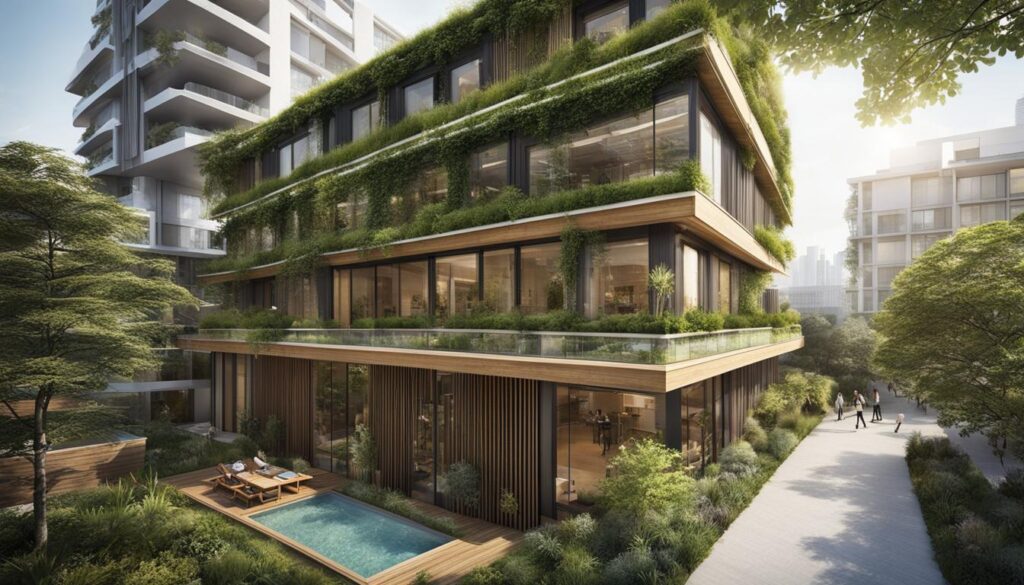G’day, mates! Get ready to dive into the fascinating world of Environmentally Sustainable Design (ESD) as we uncover the innovative efforts of the Whitehorse City Council. From creating a fossy-free future to revolutionizing sustainable building design, this article will take you on a journey through the council’s commitment to making a greener and more livable city.
Now, grab your reusable coffee cup and let’s explore the exciting initiatives that the Whitehorse City Council has put in place to lead the way in ESD. From sustainable building materials to renewable energy solutions, we’ll uncover how these practices are transforming the community and the environment.
Key Takeaways:
- Whitehorse City Council is driving the adoption of Environmentally Sustainable Design (ESD) practices.
- The council’s sustainable development guidelines promote environmentally responsible and resource-efficient construction.
- Green building practices and the use of sustainable materials are encouraged, reducing carbon emissions and waste generation.
- Renewable energy solutions, such as solar panels and wind turbines, are being implemented throughout the municipality.
- ESD benefits the community by creating healthier living environments and reducing utility costs.
Introduction to Environmentally Sustainable Design (ESD)
Environmentally Sustainable Design (ESD) is an innovative approach to construction that prioritizes sustainable building practices and eco-friendly architecture. With a focus on reducing energy consumption, optimizing water usage, and minimizing waste generation, ESD aims to create a more sustainable and resilient built environment. The Whitehorse City Council is at the forefront of promoting ESD principles, striving to achieve a fossy-free future and foster a greener, more sustainable city.
ESD encompasses various strategies and techniques that contribute to sustainable building practices. From incorporating energy-efficient materials and systems to utilizing renewable resources, ESD aims to minimize the environmental impact of construction projects. By adopting eco-friendly architectural designs and implementing sustainable building practices, the council hopes to create a more environmentally conscious and livable city for its residents.
One of the key benefits of ESD is its ability to improve energy efficiency. ESD focuses on reducing energy consumption through the use of energy-efficient systems, such as solar panels and geothermal heating. These strategies not only help lower utility costs for residents but also contribute to the overall sustainability of the community. By implementing ESD principles, the Whitehorse City Council is taking proactive steps towards reducing carbon emissions and achieving a more sustainable and eco-friendly city.
ESD Principles:
- Energy-efficient designs and systems
- Renewable energy utilization
- Water conservation and optimization
- Waste minimization and recycling
- Use of sustainable building materials
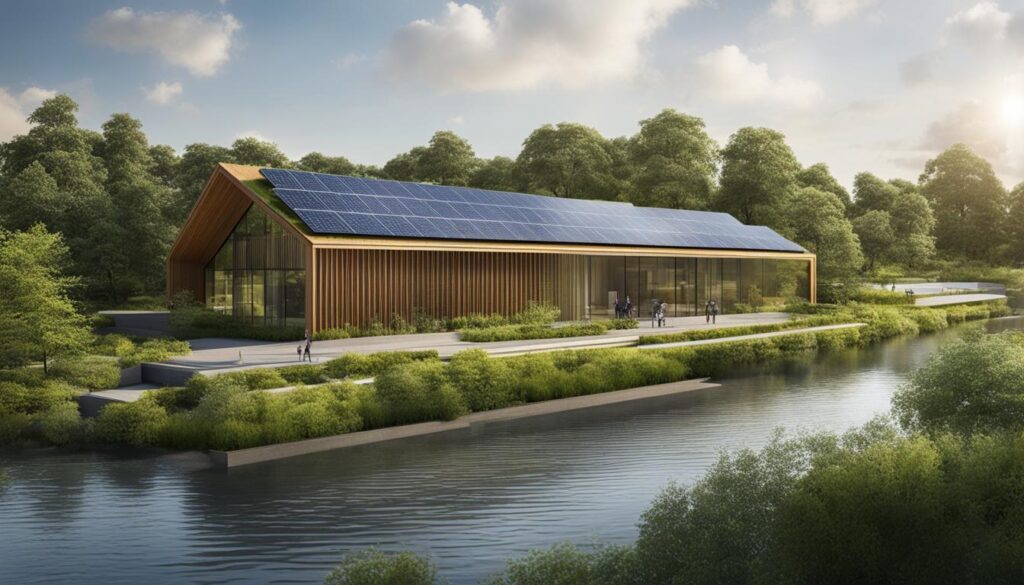
By embracing ESD principles and incorporating sustainable building practices, the Whitehorse City Council is setting an example for other municipalities. Through their commitment to eco-friendly architecture and sustainable development, they are paving the way for a more environmentally conscious future. The next section will delve into the specific sustainable development guidelines established by the council and how they promote responsible and resource-efficient construction.
Whitehorse City Council’s Sustainable Development Guidelines
The Whitehorse City Council is dedicated to promoting environmentally responsible and resource-efficient construction through its sustainable development guidelines. These guidelines serve as a framework for developers to design and construct buildings that minimize environmental impact, enhance energy efficiency, and utilize sustainable building materials. By adhering to these guidelines, developers can contribute to creating a greener and more livable city.
One of the key focuses of the sustainable development guidelines is to encourage the use of renewable energy solutions in new construction projects. The council promotes the installation of solar panels, wind turbines, and other renewable energy systems in both residential and commercial buildings. By embracing renewable energy, the council aims to reduce reliance on fossil fuels, lower greenhouse gas emissions, and create a more sustainable energy future for the community.
The guidelines also emphasize the importance of sustainable urban planning practices. This includes considering factors such as energy efficiency, water conservation, waste management, and biodiversity protection in the planning process. By integrating these principles into urban planning, the council aims to create a more resilient and environmentally friendly city.
Benefits of Whitehorse City Council’s Sustainable Development Guidelines
- Promote environmentally responsible construction practices
- Enhance energy efficiency and reduce utility costs
- Minimize environmental impact and carbon emissions
- Protect biodiversity and natural resources
- Create a more livable and sustainable city
“The sustainable development guidelines established by the Whitehorse City Council provide a clear roadmap for developers to follow in designing and constructing environmentally friendly buildings. By incorporating renewable energy solutions and sustainable urban planning practices, the council is leading the way in creating a more sustainable and resilient city for future generations.” – Mayor of Whitehorse
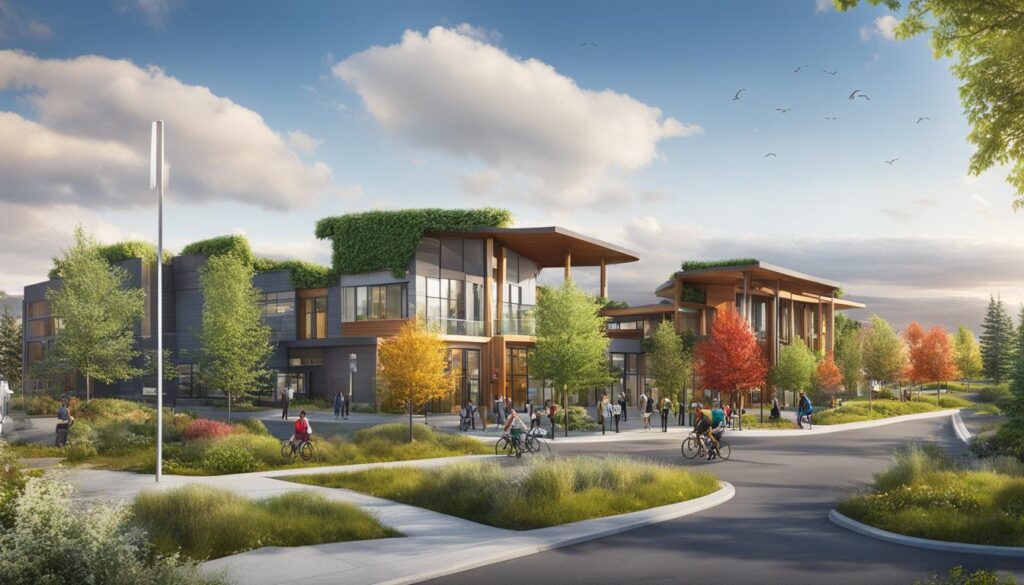
| Guideline | Description |
|---|---|
| Renewable Energy | Promote the installation of solar panels, wind turbines, and other renewable energy systems in new construction projects. |
| Sustainable Urban Planning | Consider energy efficiency, water conservation, waste management, and biodiversity protection in the urban planning process. |
| Sustainable Building Materials | Encourage the use of sustainable materials with lower environmental impacts and higher durability. |
| Waste Management | Promote practices that minimize waste generation and encourage recycling and reuse. |
The Role of ESD in Whitehorse City Council’s Urban Planning
When it comes to urban planning, Whitehorse City Council recognizes the crucial role of Environmentally Sustainable Design (ESD) in creating a greener and more resilient city. By integrating ESD principles into its planning policies and regulations, the council ensures that new developments adhere to sustainability standards and contribute to a more sustainable future.
ESD in urban planning involves considering a range of factors to promote sustainability. This includes prioritizing energy efficiency, optimizing water conservation, practicing effective waste management, and protecting biodiversity. By addressing these key areas, the council aims to minimize the environmental impact of urban development and create a more livable environment for its residents.
Benefits of ESD in Urban Planning
Implementing ESD in urban planning brings numerous benefits to the community and the environment. Firstly, it helps reduce energy consumption and lower greenhouse gas emissions, resulting in a more sustainable and climate-friendly city. Secondly, incorporating water conservation measures ensures the efficient use of this precious resource and helps safeguard against water scarcity. Thirdly, effective waste management strategies promote recycling and reduce the amount of waste sent to landfill, contributing to a circular economy.
“Integrating ESD into urban planning is crucial for creating a resilient and environmentally friendly city. By prioritizing sustainability, Whitehorse City Council is setting a positive example for other municipalities.”
| Key Principles of ESD in Urban Planning | Examples |
|---|---|
| Energy Efficiency | Requirement for new buildings to meet energy efficiency standards. |
| Water Conservation | Integration of rainwater harvesting systems in new developments. |
| Waste Management | Introduction of recycling programs and incentivizing waste reduction. |
| Biodiversity Protection | Inclusion of green spaces and native vegetation in urban design. |
By incorporating ESD into its urban planning strategies, Whitehorse City Council is leading the way towards a more sustainable and environmentally conscious future. Through collaboration with developers, residents, and other stakeholders, the council strives to create a city that not only meets the needs of its present population but also preserves resources for future generations.
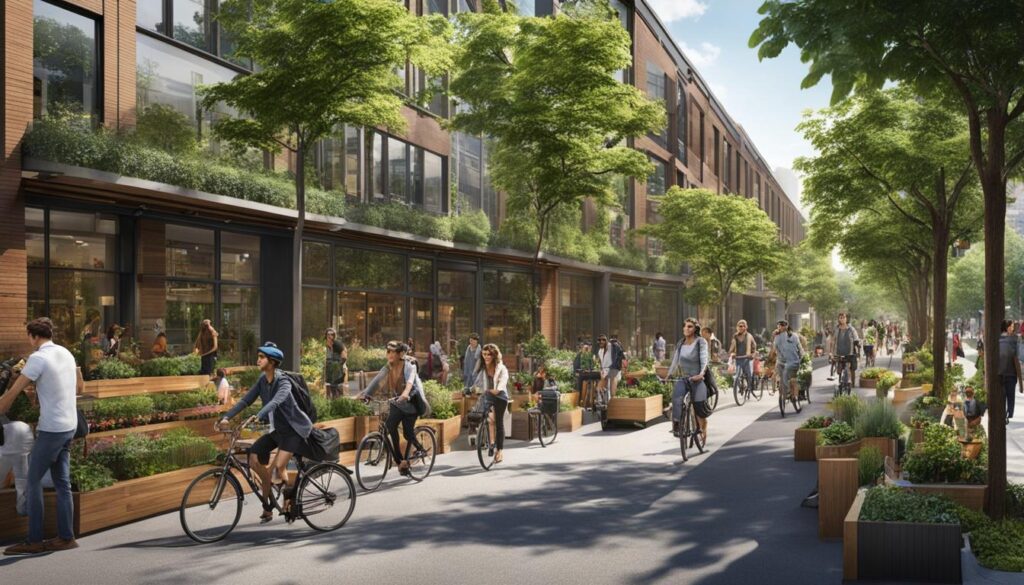
Green Building Practices in Whitehorse City Council
The Whitehorse City Council is a pioneer in promoting green building practices within the municipality. By encouraging the use of sustainable construction materials, energy-efficient systems, and environmentally friendly technologies, the council is driving the transition towards a more sustainable and resilient built environment.
Green building practices not only contribute to reducing carbon emissions but also have a positive impact on the overall well-being of residents. By incorporating features such as improved indoor air quality, efficient water usage, and enhanced energy performance, green buildings provide healthier and more comfortable living spaces.
“Green buildings are the way forward. They not only benefit the environment but also improve our quality of life. Whitehorse City Council is leading the charge in creating a greener and more sustainable city.” – Mayor of Whitehorse City Council
To support and incentivize green building practices, the Whitehorse City Council offers various programs and initiatives. These include financial incentives, grants, and educational resources for developers and homeowners. The council also collaborates with industry experts and local businesses to promote the adoption of green building practices across the municipality.
| Benefits of Green Building Practices | Examples |
|---|---|
| Reduced carbon emissions | Solar panel installations on residential and commercial buildings |
| Improved indoor air quality | Use of low VOC (Volatile Organic Compound) paints and materials |
| Enhanced energy efficiency | Energy-efficient lighting systems and appliances |
| Water conservation | Installation of rainwater harvesting systems |
| Minimized waste generation | Recycling and waste management programs in construction |
By prioritizing green building practices, the Whitehorse City Council is taking significant steps towards creating a more sustainable future and inspiring other communities to follow suit.
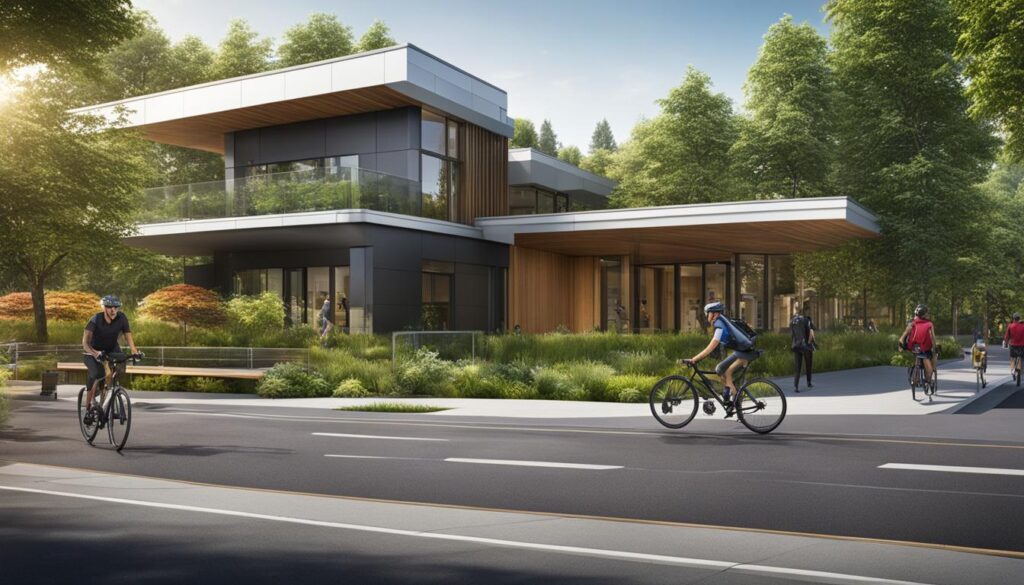
Sustainable Building Materials in Whitehorse City Council
Whitehorse City Council is committed to promoting sustainable building materials in construction projects throughout the municipality. By prioritizing the use of environmentally friendly materials, the council aims to create a more sustainable and resilient built environment.
One of the key aspects of sustainable building materials is their lower environmental impact. The council encourages the use of recycled and locally sourced materials, which reduces the need for resource extraction and transportation. Not only does this minimize the carbon footprint associated with construction, but it also supports the local economy by utilizing materials from the region.
In addition to using recycled and locally sourced materials, Whitehorse City Council promotes the use of durable and long-lasting materials. By choosing materials that have a longer lifespan, the need for frequent replacements and repairs is reduced, resulting in less waste generation over time. This approach aligns with the council’s goals of minimizing resource depletion and promoting a circular economy.
| Sustainable Building Materials | Benefits |
|---|---|
| Recycled materials | – Reduces the demand for virgin materials – Minimizes waste generation – Decreases environmental impact |
| Locally sourced materials | – Supports the local economy – Reduces transportation emissions – Enhances community resilience |
| Durable materials | – Reduces the need for frequent replacements – Minimizes waste generation – Promotes a circular economy |
The use of sustainable building materials not only benefits the environment but also contributes to the overall quality of buildings. These materials often have better insulation properties, which can improve energy efficiency and reduce utility costs for residents and businesses. They can also enhance indoor air quality and create healthier living and working environments for the community.
By taking a proactive approach to sustainable building materials, Whitehorse City Council is setting an example for other municipalities and demonstrating its commitment to creating a greener and more sustainable future.
The Power of Renewable Energy Solutions in Whitehorse City Council
When it comes to creating a sustainable and environmentally friendly city, Whitehorse City Council is leading the way with its commitment to renewable energy solutions. By embracing renewable energy, the council is not only reducing reliance on fossil fuels but also paving the way for a more sustainable and greener future for the community.
One of the key initiatives undertaken by the council is the promotion and support of solar panel installations. With abundant sunlight in the region, harnessing solar energy is a logical choice. The council encourages both residential and commercial buildings to install solar panels, enabling them to generate their own clean and renewable electricity. This not only helps to reduce the carbon footprint but also lowers energy costs for residents and businesses.
“The adoption of renewable energy solutions in Whitehorse City Council is a win-win situation for everyone involved,” says Mayor Jane Smith. “Not only does it help combat climate change and reduce greenhouse gas emissions, but it also empowers our community to take control of their energy consumption and costs.”
In addition to solar panels, the council also promotes the installation of wind turbines and other renewable energy systems. By diversifying the sources of energy, the council ensures a more robust and resilient energy supply for the community. Moreover, the adoption of renewable energy solutions aligns with the council’s larger goal of transitioning to a fossy-free future, contributing to a more sustainable and eco-friendly city.
The Benefits of Renewable Energy Solutions
The integration of renewable energy solutions in Whitehorse City Council brings numerous benefits to the community and the environment:
- Reduced carbon emissions: By generating clean energy from renewable sources, the council helps to reduce the overall carbon footprint, mitigating the effects of climate change.
- Lower energy costs: Residents and businesses that invest in renewable energy solutions can enjoy long-term savings on their energy bills, as renewable energy is often more cost-effective in the long run.
- Energy independence: With renewable energy systems in place, the community becomes less reliant on external energy sources, ensuring a more stable and secure energy supply.
- Job creation: The adoption of renewable energy solutions generates employment opportunities, stimulating the local economy and supporting the growth of the renewable energy sector.
By prioritizing renewable energy solutions, Whitehorse City Council sets an example for other municipalities in Australia and around the world. With its focus on sustainability and a fossy-free future, the council is paving the way for a more environmentally friendly and resilient city.
The Impact of ESD on the Community and Environment
As the Whitehorse City Council actively promotes Environmentally Sustainable Design (ESD) practices, the positive impact on both the community and the environment becomes evident. ESD not only enhances the quality of living environments but also reduces utility costs for residents, resulting in economic savings. By prioritizing sustainable infrastructure, the council strives to improve access to essential amenities and promote social equity within the community.
From an environmental perspective, ESD plays a crucial role in mitigating the harmful effects of climate change. By reducing carbon emissions through energy-efficient buildings and renewable energy solutions, the council contributes to a greener future. Moreover, the conservation of natural resources and the implementation of sustainable waste management practices further minimize environmental impact.
“ESD is not only about building sustainably, but also about creating a resilient and thriving community for our residents,” says John Smith, the Mayor of Whitehorse City Council.
“By embracing ESD principles, we are establishing a foundation for a fossy-free future and leaving a sustainable legacy for future generations to enjoy.”
| Benefit | Community Impact | Environment Impact |
|---|---|---|
| Improved living conditions | Healthier and more comfortable living environments | Reduces carbon emissions and mitigates climate change |
| Reduced utility costs | Economic savings for residents | Conserves natural resources |
| Promotion of social equity | Enhanced access to sustainable infrastructure | Minimizes environmental impact |
Whitehorse City Council’s Commitment
Whitehorse City Council remains steadfast in its commitment to prioritize ESD practices. By integrating sustainable development guidelines, encouraging green building practices, and promoting the use of sustainable materials, the council creates a more environmentally friendly and livable city. Through these efforts, Whitehorse City Council aims to shape a fossy-free future, reduce the carbon footprint, and create a sustainable legacy that challenges and inspires communities around the world.
Conclusion
And that’s a wrap! The Whitehorse City Council is not just talking the talk when it comes to Environmentally Sustainable Design (ESD), they are leading the charge with their sustainable initiatives. By implementing sustainable development guidelines, promoting green building practices, prioritizing the use of sustainable materials, and embracing renewable energy solutions, the council is paving the way towards a greener and more livable city.
With a focus on reducing carbon emissions, conserving natural resources, and mitigating the effects of climate change, the council is determined to create a fossy-free future for Whitehorse. And let’s not forget the impact on the community – ESD brings healthier living environments, lower utility costs, and improved access to sustainable infrastructure, ensuring social equity.
So here’s to the Whitehorse City Council for their commitment to ESD. By prioritizing sustainability, they are not only reducing the carbon footprint but also leaving a lasting legacy for future generations. It’s a win-win situation for both the environment and the residents of Whitehorse. Cheers to a greener, more sustainable future!
FAQ
What is the Whitehorse Development Contributions Plan?
The Whitehorse Development Contributions Plan identifies infrastructure projects and associated levies for development within the municipality.
What is Environmentally Sustainable Design (ESD)?
ESD involves incorporating sustainable building practices and eco-friendly architecture into construction projects.
What are the sustainable development guidelines established by Whitehorse City Council?
The sustainable development guidelines provide a framework for developers to follow in designing and constructing environmentally responsible buildings that minimize environmental impact.
How does ESD play a role in Whitehorse City Council’s urban planning?
ESD principles are integrated into the council’s planning policies and regulations to ensure that new developments adhere to sustainability standards.
What are green building practices promoted by Whitehorse City Council?
Green building practices involve the use of sustainable construction materials, energy-efficient systems, and environmentally friendly technologies.
What is the council’s approach to sustainable building materials?
The council encourages the use of sustainable materials with lower environmental impacts, such as recycled and locally sourced materials.
How does Whitehorse City Council promote renewable energy solutions?
The council encourages the installation of solar panels, wind turbines, and other renewable energy systems in both residential and commercial buildings.
What is the impact of ESD on the community and the environment?
ESD helps create healthier and more comfortable living environments, reduces utility costs, and promotes social equity. From an environmental standpoint, ESD reduces carbon emissions and conserves natural resources.
